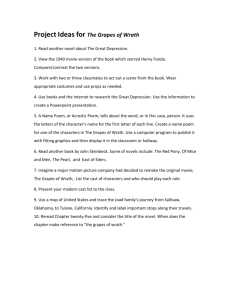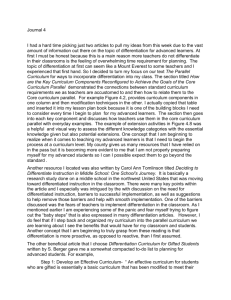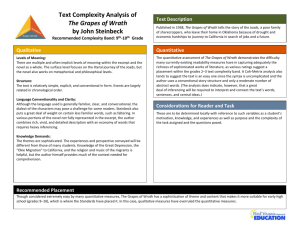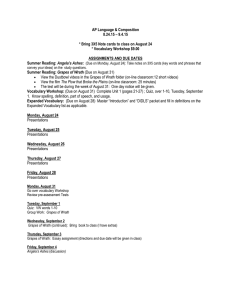File - Onslow County AIG
advertisement
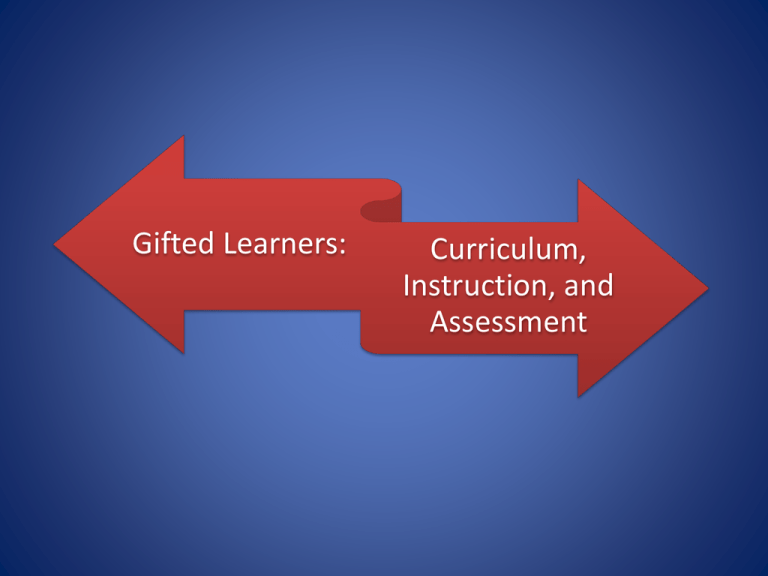
Gifted Learners: Curriculum, Instruction, and Assessment Teacher trained in gifted education Content Accelerated and enriched curriculum Needs, Characteristics, Interests, and Learning Styles Product Process Communicates highlevel understanding Critical and creative thinking Assessment Instruction Learning with other students with advanced potential 2 Elements of Differentiated Content Substantive content—focus on concepts Provision for acceleration and compression of content In-depth focus including enrichment More advanced reading and vocabulary levels Use of primary sources, artifacts, and real objects Interdisciplinary connections Includes in-depth and critical analysis Fosters creative expression Exploration of areas of choice 3 Analysis Critique Propaganda Struggle Big Picture Big Ideas Common man Social justice Identity Journey Role of government 4 Definition of Curriculum Curriculum: A set of for a targeted audience experiences (VanTassel-Baska & Stambaugh, 2006) 5 Elements of Differentiated Instruction Working with intellectual peers Developing habits of mind of the experts in the field Opportunities for independent research in areas of interest Opportunities for student choice Consistently focused in critical and creative thinking Differentiation for individual readiness and learning style 6 Models inquiry process Stimulates different ways of thinking Question Asking Clarifies key ideas Inspires curiosity 7 Tips for Questioning • Don’t accept the first answer: What else? Other ideas? Solicit multiple • Encourage responses to the responses of others responses • Use Bloom’s verbs to get at HOTS Generate open- • Ask for support for ideas ended questions 8 Cubing Contracts Tiering Anchoring activities Centers Strategies Exit cards Tic-tac-toe Jigsaw RAFT Think dots Task cards Organizers 9 Elements of Differentiated Assessment Effective communication in oral, written, and visual formats Demonstration of critical and creative thinking Real audiences Effective use of a variety of technology/media K–12 coordination of opportunities for advanced products 10 Create Create Evaluate Evaluate Analyze Analyze Apply Apply Understand Understand Remember Remember Example: The Grapes of Wrath by John Steinbeck Substantive • Influence of geography (or economics) content with focus on sociology (or political agendas) on concepts: Provision for acceleration: In-depth focus including enrichment: • Use this in middle school • Cover more reading in less time • Look at art and music related to migrant workers or Great Depression or Dust Bowl 12 Elements: The Grapes of Wrath Habits of mind of experts: • Look at point of view • Read primary sources Demonstration of advanced understanding through projects: • Socialism vs. the American Dream • Development of sense of community 13 Opportunities for independent learning: • • • • Role of women—feminism Use of film techniques to convey the story California’s migrant culture Biblical imagery and its place in the era Consistently focused on critical and creative thinking: • Power of writing to bring forth social justice Interdisciplinary: • Geography, history, economics, politics, sociology, art, music 14 Questions: The Grapes of Wrath • What data or evidence from the novel would suggest that kindness may be more common among the poor than the rich? • What inferences do you draw from the following statement by Ma? “Up ahead they’s a thousan’ lives we might live, but when it comes, it’ll on’y be one.” • What are the consequences for individuals and society of the Great Depression? 15 Bloom’s Questions: The Grapes of Wrath • Who are the main characters? • What causes the journey to California in the first place? • Compare the move of the migrant workers out of Oklahoma to the forced moves of Native American tribes. • Analyze the role of Rose of Sharon. What causes her to behave as she does? • Synthesize the feelings that Casy has about being a preacher. • Evaluate the decision to move to California? Was it the right one? • Create a new ending for The Grapes of Wrath and construct the justification for it being a viable alternative. 16 Problem-Based Learning (PBL): The Grapes of Wrath You have been told to investigate the working and living conditions of migrant workers in California in the 1930s. Make recommendations for safeguards to be put in place to ensure that the children of these workers have an education and the families have sanitary living conditions and access to medical care. 17 PBL Questions • Given the facts of the novel, what do you know about the living conditions of migrant workers including the education of their children? • What else do you need to know? • What sources would be useful to explore? • Are there parallel situations still in existence? 18 Differentiation: At All Levels of Design! Goals Outcomes and assessment Strategies Content/ materials/ resources Activities and projects 19 Differentiation for the Gifted Not just accelerated Not just choice Not just a different assignment Not just different Not just an extension Qualitatively different in all aspects Not just a different word list 20 Differentiation: Social Studies • Describe the American • Identify three similarities and Revolutionary War and the three differences between American Civil War. Include the Revolutionary War and information about: the Civil War. Explore topics in depth such as : weaponry, – Causes political positions of parties – Main leaders involved, strategies, and – Outcomes outcomes. You may select another topic with teacher approval. 21 Differentiation: Interdisciplinary • Construct a bar graph showing the populations of: – – – – – – Afghanistan (27,090,000) China (1,325,000,000) Egypt (72,500,000) Finland (5,276,000) Nigeria (162,083,000) United States (302,000,000) • Find the population of China for the past 10 years. • Enter this data into an Excel spreadsheet. • Construct a graph using the Excel tools. • If there is uneven growth, investigate possible causes. • Is the trend line linear or exponential? • Can you predict the population 10 years out? 22 Differentiation: Interdisciplinary • Using resources found in the library, find information on a famous inventor posted from the list on the board. Answer these questions : – What led to the discovery? – Describe early attempts. – How well was this idea accepted? – What was the outgrowth of this invention? • Select one of the following topics to research and construct a persuasive essay defending your position. Use multiple sources, including primary sources, to construct your position. – The rate of new discoveries has slowed in recent years. – Most new ideas are developed by large companies. – The most important new idea was the Internet. 23 Differentiation: Literature • Describe the setting from the story. • Describe the setting and why that is crucial to the author’s purpose. Cite specific examples from the story to illustrate your point(s). 24 Differentiation Instruction or Assessment Activity • With a colleague, take one of the following topics and give an example of a learning activity or assessment appropriate for grade level learners and what that same learning activity looks like for gifted learners: – Bridge to Terabithia – End of World War II – Using percents – Scientific method 25 What Is the Big Picture? K–12 Sequence Year Units Lessons Activities 26 First Grading Period Second Grading Period Third Grading Period Fourth Grading Period Big ideas Big ideas Big ideas Big ideas Content Content Content Content Skills Skills Skills Skills Assessments Assessments Assessments Assessments Activities Activities Activities Activities Research Research Research Research Self-regulation Self-regulation Self-regulation Self-regulation 27 Grade 1 Grade 2 Grade 3 Grade 4 Big ideas Big ideas Big ideas Big ideas Content Content Content Content Skills Skills Skills Skills Major projects Major projects Major projects Major projects Research skills Research skills Research skills Research skills Self, affective, career Self, affective, career Self, affective, career Self, affective, career 28 K–8 Curriculum Map Subject/Grade Reading/language arts Social studies Math Science Affective/career Research Self-regulation K 1 2 3 4 5 6 7 8 A Good Activity Occasionally 30 A Planned Set of Experiences 31 32 Core curriculum designed at the district level for learners with advanced potential Vertical articulation K–12 Just Say “No” to Random Acts of Gifted Education RAGE 33
